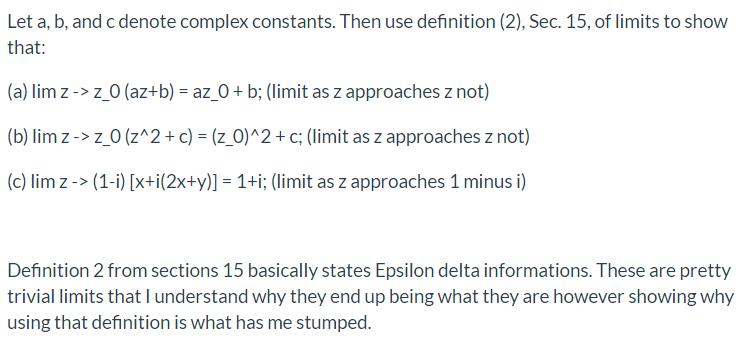Question
Let a, b, and c denote complex constants. Then use definition (2), Sec. 15, of limits to show that: (a) lim z -> z_0

Let a, b, and c denote complex constants. Then use definition (2), Sec. 15, of limits to show that: (a) lim z -> z_0 (az+b) = az_0+ b; (limit as z approaches z not) (b) lim z -> z_0 (z^2+ c) = (z_0)^2 + c; (limit as z approaches z not) (c) lim z -> (1-i) [x+i(2x+y)] = 1+i; (limit as z approaches 1 minus i) Definition 2 from sections 15 basically states Epsilon delta informations. These are pretty trivial limits that I understand why they end up being what they are however showing why using that definition is what has me stumped.
Step by Step Solution
3.31 Rating (151 Votes )
There are 3 Steps involved in it
Step: 1
Answer Definition of the limit The l...
Get Instant Access to Expert-Tailored Solutions
See step-by-step solutions with expert insights and AI powered tools for academic success
Step: 2

Step: 3

Ace Your Homework with AI
Get the answers you need in no time with our AI-driven, step-by-step assistance
Get StartedRecommended Textbook for
Linear Algebra A Modern Introduction
Authors: David Poole
4th edition
1285463242, 978-1285982830, 1285982835, 978-1285463247
Students also viewed these Accounting questions
Question
Answered: 1 week ago
Question
Answered: 1 week ago
Question
Answered: 1 week ago
Question
Answered: 1 week ago
Question
Answered: 1 week ago
Question
Answered: 1 week ago
Question
Answered: 1 week ago
Question
Answered: 1 week ago
Question
Answered: 1 week ago
Question
Answered: 1 week ago
Question
Answered: 1 week ago
Question
Answered: 1 week ago
Question
Answered: 1 week ago
Question
Answered: 1 week ago
Question
Answered: 1 week ago
Question
Answered: 1 week ago
Question
Answered: 1 week ago
Question
Answered: 1 week ago
Question
Answered: 1 week ago
Question
Answered: 1 week ago
Question
Answered: 1 week ago
Question
Answered: 1 week ago
View Answer in SolutionInn App



